#cluna
Text
favourite t100 “crackships”:
clarke x luna - never getting over them
monty x miller - miller deserved more focus
jasper x octavia - s1/s2 them were adorable
bellamy x murphy - s1 bodyguard/enemies vibes
raven x octavia - having only ONE scene is a crime
harper x fox - girlfriends on the ark 100%
#the 100#clarke x luna#cluna#???#never heard of a name for this ship#monty x miller#minty#jasper x octavia#jactavia#bellamy x murphy#murphamy#raven x octavia#octaven#harper mcintyre#fox the 100#harper x fox
15 notes
·
View notes
Text
São poucas as almas que contemplam a Minha Paixão com um verdadeiro afeto. Diário 737.
#Jesus#apesar#estar#doente#decidi#rezar#hoje#flagelado#costume#Senhor#junto#cluna#instante#poucas#almas#contemplam#minhapaixao#verdadeiro#afeto#concedo#graças#paixao#horasanta#piedosamente#meditam#sobre#santafaustina#diariodesantafaustina
0 notes
Text
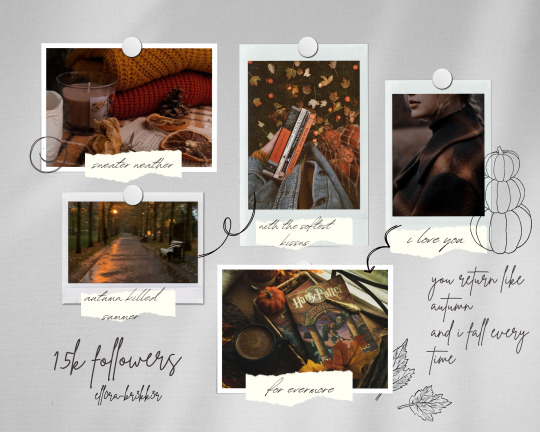
1.5k followers... woooww thank you guys so so much! fall is finally hereeeeeeee so obviously, that's the theme :)
closed
the main fandoms for this event are the grishaverse and the wizarding world both golden and marauders era (please specify if you want marauders or golden). but any of the characters from my list will be accepted! please let me know if you have a preference for pronouns, otherwise i'll default to she/her !!!
masterlist | character list | navigation

willow ~ blurb requests! y'all know how this works, send me a prompt along with a character and i'll write you a small blurb (blurbs will be posted on my writing blog (@/ell0ra-br3kk3r-writes))
champagne problems ~ ships! send me your ideal fall/autumn themed date and i'll ship you with a character (please specify gender and fandom prefrence)
gold rush ~ send me a few photos of your clothing style/dream clothing style and i'll tell you what fandom you belong in (from the fandoms/books i've read)
'tis the damn season ~ send me this along with a fic you've written (for the fandoms i write for) and i'll tell you my favorite parts, it's like i'm annotating your fic the way i do my books
tolerate it ~ send me a few of your favorite fall activites and a character and i'll make a mood board
no body no crime ~ send me this along with your favorite character and i'll make you a mini mood board and playlist based off the vibes your blog gives (moots only)
happiness ~ random asks! cym, kmk, or any other random questions or games!
tags:
@jahayla-parker @maliciousbrekker @romanticvampire @nikfigueiredo @brekkershadowsinger @brekkers-desigirl @alexis-angelsss @thebestieyoureinlovewith @futurecorps3 @doyouknowwhoyouare13 @basicallyjustmuggleremuslupin @hope92100 @ketterdam-snack-bar @sleepless-crows @clunaes @imabee-oralizard @magicchai @miss-celestial-being @wolfstardaughter-jj @starstruckwillows @stars-havefallen @kitty0621 @sp1rit-realm
#1.5k followers#follower celebration#kaz brekker x reader#jesper fahey x reader#nikolai lantsov x reader#harry potter x reader#draco malfoy x reader#sirius black x reader#remus lupin x reader#james potter x reader
67 notes
·
View notes
Text
👑 𝐂𝐎𝐍𝐓𝐑𝐈𝐁𝐔𝐓𝐎𝐑 𝐋𝐈𝐍𝐄-𝐔𝐏 🌿
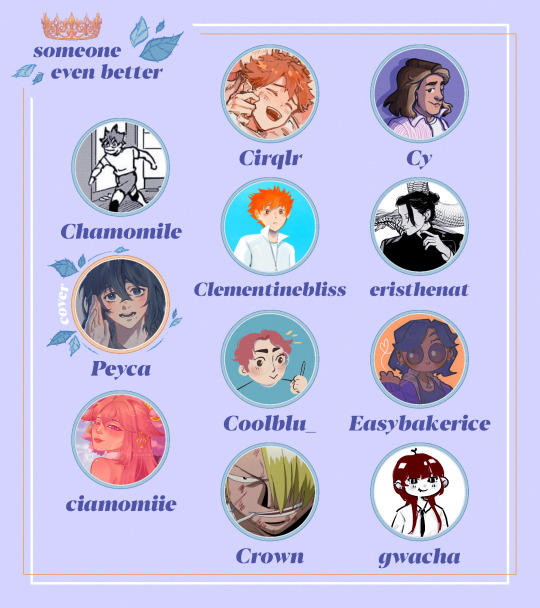
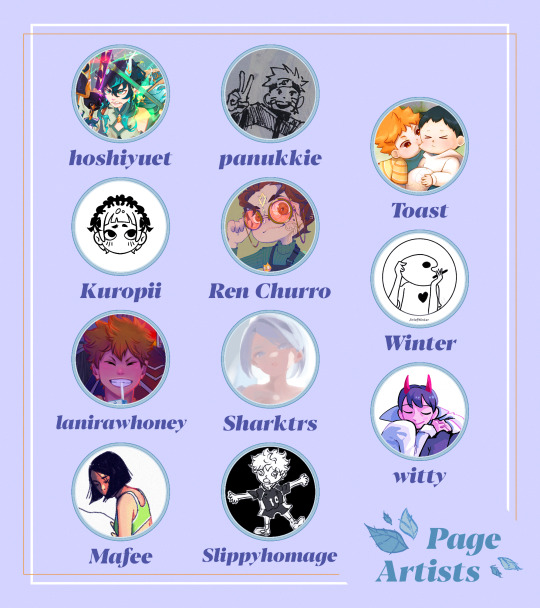
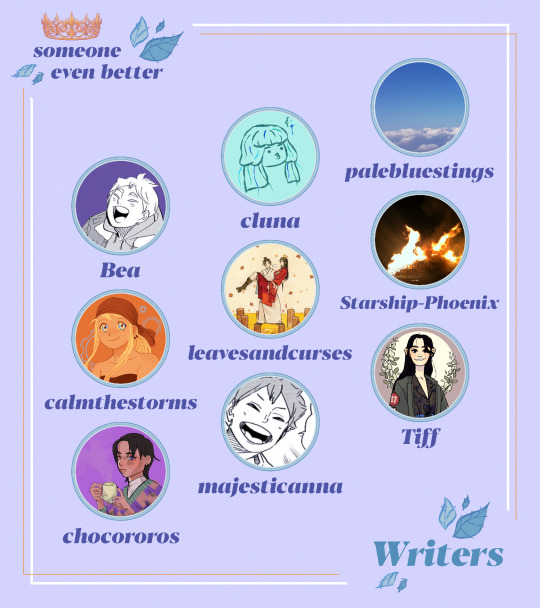
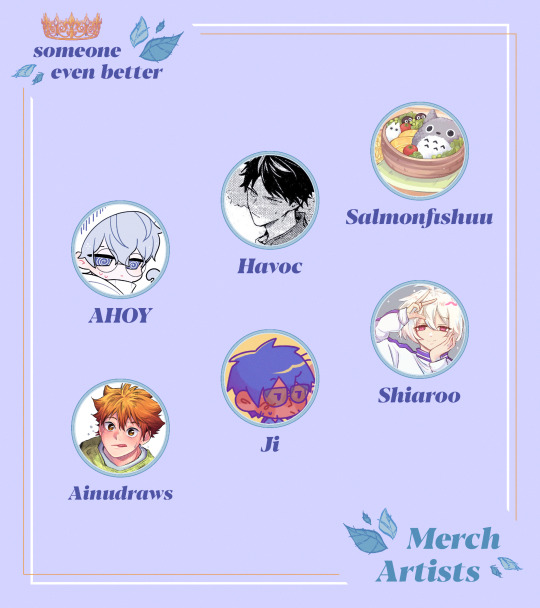
Our first check-in has passed—we think it’s time for you to meet the wonderful contributors of Someone Even Better! Please give them a warm welcome, they’re all hard at work creating some amazing things!
↓ Contributors tagged below the break! ↓
𝐏𝐀𝐆𝐄 𝐀𝐑𝐓𝐈𝐒𝐓𝐒:
@chamomilebears | Peyca | @ciamomiie | Cirqlr | Clementinebliss | Coolblu_ | @cr0wn1ng | @doodledraw | @eristhenat | Easybakerice | @gwacha | hoshiyuet | @kuropii6 | @lanirawhoney | @rnafee | panukkie | @renchurro | Sharktrs | Slippyhomage | @strawberryswirlix | Winter | witty
𝐖𝐑𝐈𝐓𝐄𝐑𝐒:
Bea | calmthestorms | @seishun-emergency | cluna | @leavesandcurses | @majesticanna | palebluestings | @starship--phoenix | @makhis
𝐌𝐄𝐑𝐂𝐇 𝐀𝐑𝐓𝐈𝐒𝐓𝐒:
@y-o-h-a | @ainudraws | @izucaii | @mirarasol | Salmonfishuu | @shiaroo
Carrd | Retrospring
—Reblogs are appreciated, thank you! @zine-scene @atozines @fandomzines @zinefeed
#contributor lineup#contributor spotlight#someone even better zine#someone even better#anime zine#haikyuu zine#fan zine#fandom zine#zine#kagehina#hinakage#kageyama x hinata#hinata x kageyama#hinata shouyou#shouyou hinata#kageyama tobio#tobio kageyama#haikyuu#ハイキュー!!#zine announcement#zine update
25 notes
·
View notes
Text
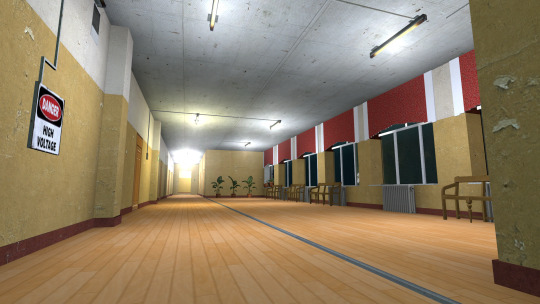
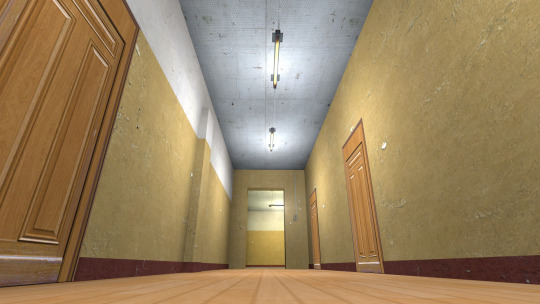


pleasebringback2021december
uploaded by Cluna
30 notes
·
View notes
Text
Contributor Announcements

🚨CONTRIBUTOR ANNOUNCEMENT🚨
We had some fantastic contributors answer the call and join our team! No need to worry about your safety with these rescue workers on the job. They're here to save the day AND create amazing work.🩺
See below the cut for our complete list of contributors!
#BNHAOnCall

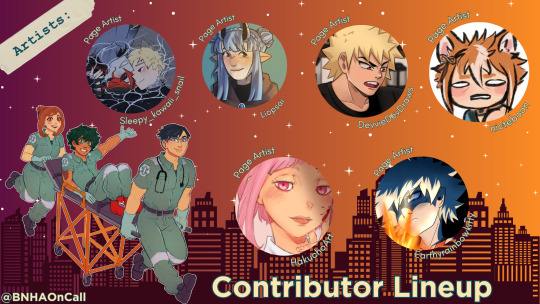
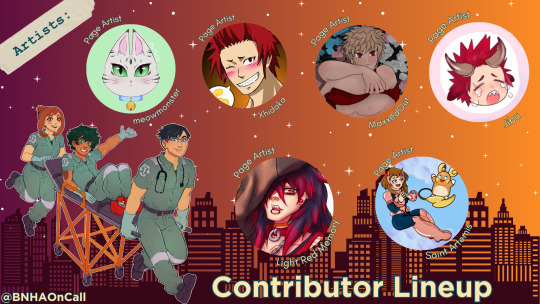
Page Artists
Meghan LeVaughn
@0ceanbleuu
Vintagehoneybees
@tardisgrump
Barddro
Quirkred
Sleepy_kawaii_snail
Liopsai
DevvieDevDraws
Nicteboon
@hakucho-art
Earthyrainbowkitty
Meowmonster
@xhidaka
MaxxedOut
@xji-buuux
Light Red Memory
Saint Artemis

Merch Artists:
@shiniidekulove
@skartlie
Vanil
@ferdiniascaeles
Writers:
Pbstings
@cryptid-crawly

Writers Continued:
@draphrawrites
Izzy_Beta
cluna
Magpie in a Chemise
Starry
@samisnotlegend
#bnha#bnha on call#on call zine#zines#bnha zines#firefighters#first responders#paramedics#police officers#zine announcement#contributor announcement#zine promo
16 notes
·
View notes
Text
TAGLIST for the phoenix and the crow
@katherinereid @littlecat21 @jahayla-parker @maliciousbrekker @brekkershadowsinger @brekkers-desigirl @clunaes @wonderland2425 @bookloverfilmoholic @karensirkobabes @bookworm-center @el-de-phi @so-get-this-sammy @skittleabyss @crispy-croke @cometsghost @auttumnsayshi
if you want to be added or taken off, please comment on this post! i know i'm missing people, so sorry!
39 notes
·
View notes
Text
The timeline of the next ATW fanfic is so fucking bonkers you people are gonna think ive lost my mind:
Julia... Ahk Nicky --Pyrus Pyrus. Pyrus Pyrus Pyrus Pyrus Cluna Pyrus Chauncey Dallas for some reason... CAAAAAMEEEOOOOS Pyrus Lawix Lawix JuuuuUUUUULIA --- JEEEEEEEEDDDDTAVIIIIUUUUUUUUS

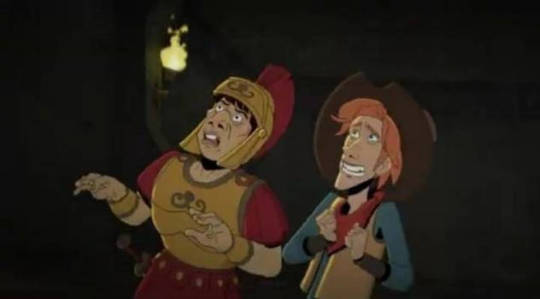
I need to be taken out into a field and euthanized
18 notes
·
View notes
Text

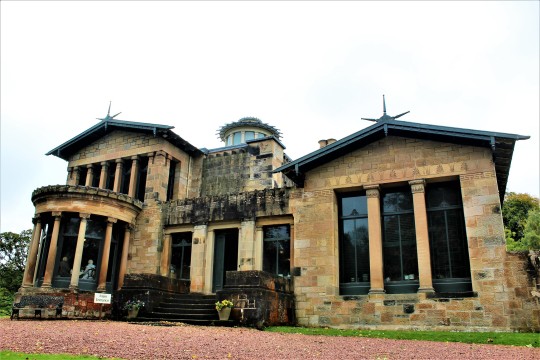

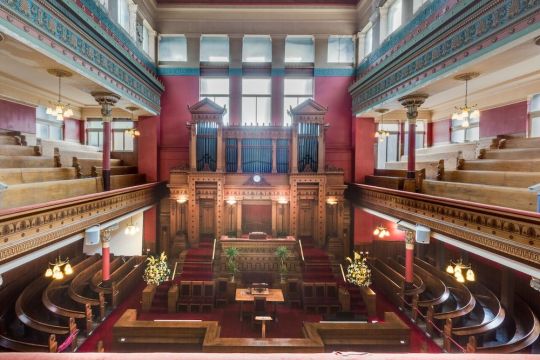
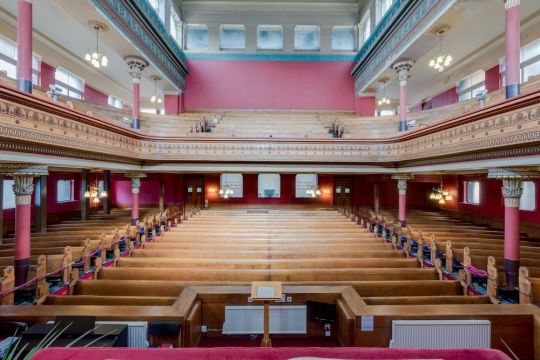
On March 22nd 1875, Alexander “Greek” Thomson died in Glasgow.
Thomson was an architect and architectural theorist in Victorian Glasgow and Scotland.
Thomson was born on 9th April, 1817, to a bookkeeper, John Thomson, and his wife, Elizabeth Cooper Thomson. He was the ninth of twelve children, but his father died when he was just seven years old.
More tragedy followed, as Alexander’s mother, sister, and three of his brothers died between 1828 and 1830. Alexander’s older brother, William, took in the remaining children. They lived together at a house in Hangingshaw, south of Glasgow, with William’s wife and child.Thomson’s career properly began when he was apprenticed to Robert Foote, a Glasgow architect. Later, he was offered a post in the office of the draughtsman John Baird. Together, John Baird II and Thomson set up their own practice in 1848. As well as his business partner, Baird was Thomson’s brother-in-law, having married Thomson’s sister, Jessie, in 1847. Thomson was married on the same day to Jane Nicholson, in a double wedding ceremony with Baird and his bride.
The Egyptian Halls Building on Union Street, Glasgow. Built by Alexander "Greek" Thomson in 1871.
Between 1856 and 1857, Thomson designed and built the Caledonia Road Free Church. Sadly, the interior was destroyed in a fire in 1965, but the exterior still remains.It is a notable work due to its asymmetrical layout and its combination of styles. These styles include ancient Greek and provincial Italian.After nine years of working with Baird, Thomson set up a practice with his brother George, heralding the start of his most productive years as an architect. He built two more churches, Queen’s Park United Presbyterian Church and St Vincent Street Church.The latter is the only complete surviving church of Thomson’s, as Queen’s Park Church was destroyed in the Second World War.
Between 1856 and 1857, Thomson designed and built the Caledonia Road Free Church. Sadly, the interior was destroyed in a fire in 1965, but the exterior still remains.It is a notable work due to its asymmetrical layout and its combination of styles. These styles include ancient Greek and provincial Italian. After nine years of working with Baird, Thomson set up a practice with his brother George, heralding the start of his most productive years as an architect.He built two more churches, Queen’s Park United Presbyterian Church and St Vincent Street Church., the exterior and interior are among the pics. The church is the only complete surviving one of Thomson’s, as Queen’s Park Church was destroyed in the Second World War. Greek influence Thomson, at first, combined several different architectural styles, such as Greek, Italian, Egyptian and Levantine, but later, the Greek style won through.Perhaps the best example of his Greek influence is Holmwood House, as seen in the second pic, which is now owned by the National Trust for Scotland.During renovations of the house, nineteen panels of classical frieze were discovered, which depict scenes from Homer’s Iliad. Thomson has also been credited with the introduction of some elements of sustainable housing.In 1868, he submitted designs to the Glasgow City Improvement Trust, which called for open-ended tenements and glazing, the former providing ventilation, and the latter providing warmth and protection.Alexander Thomson died on this day, 1875, in one of his own houses, on Moray Place in Glasgow.He was buried in Gorbals Necropolis four days later. His widow, Jane, joined him in 1889. One of his most important legacies was the Alexander Thomson Travelling Studentship, which allowed Charles Rennie Mackintosh to study architecture in Glasgow.In 1897, William Clunas, one of Thomson’s former assistants, wrote a glowing description of his employer: “His general appearance was indeed, very much in harmony with the strength and elegance which he imparted to the structures he designed, while the genial smile which so often overspread his face might be fittingly compared to the finished enrichment which was so marked and pleasing a feature of his compositions.”
14 notes
·
View notes
Photo

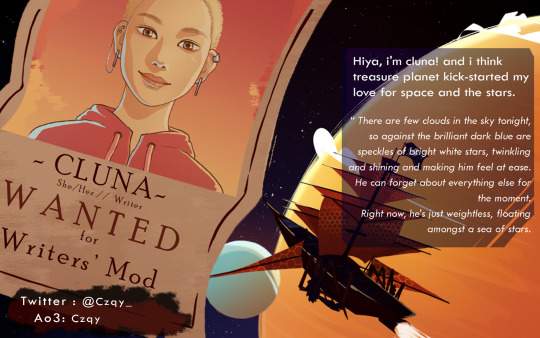
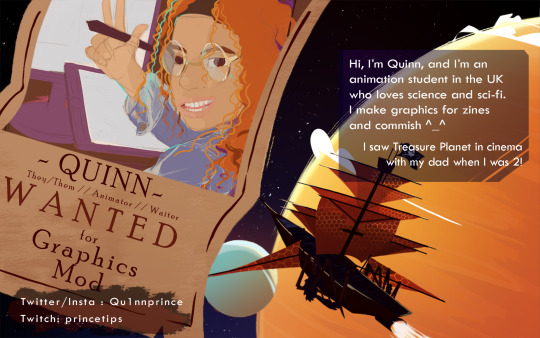
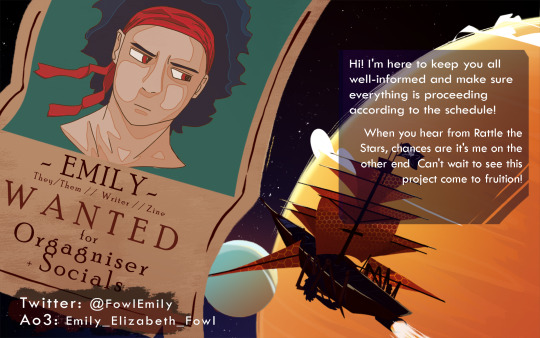
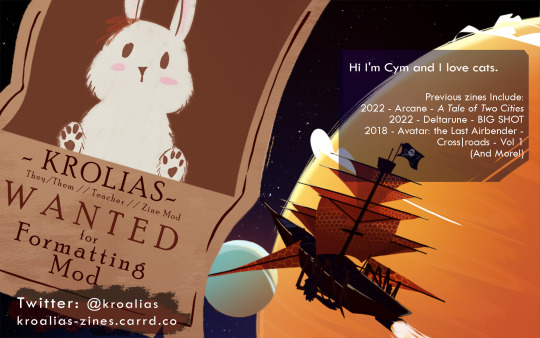
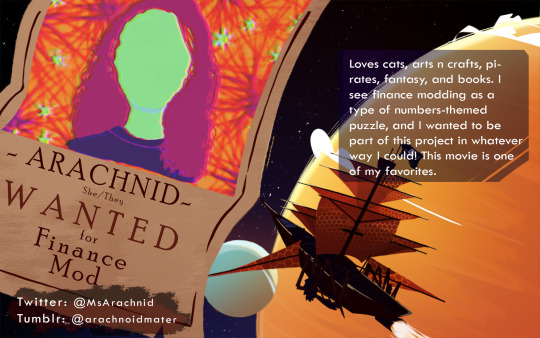
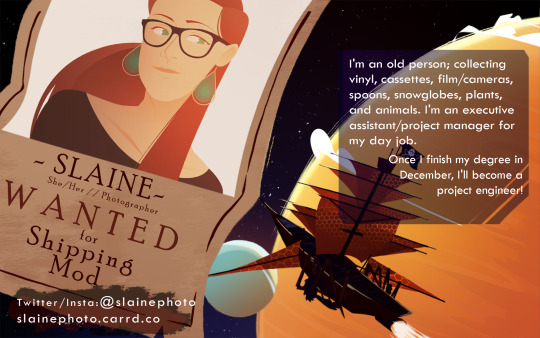
Those of you who keep a close eye on our carrd have already seen those, bue now... It's time to officially introduce our mod team!
First up: Our Art Mod, Gem! They will take care of our small army of artists and ensure smooth sailing throughout the production period!
Cluna is our Writing Mod - she'll be around to help our writers produce their best works via advice and beta!
Next up is Quinn, our Graphics Mod! Most of the amazing graphics you've seen on our acounts were made by them, and you'll see more of those in the future <3
Emily handles Organization and SocMed - when you hear from us, it's usually them on the other end! (hi 👋)
Only the best to handle our Formatting! Kroalias took part in more zines than we can count, and all of them turned out amazing!
Our Finance and Production Mod is Arachnida! The merch they'll get us will be out of this world for sure!
Slaine will be handling the Shipping! She'll be the one to send y'all the goodies 🥰 Let's hope they won't get intercepted by pirates...
We want to make this project enjoyable for everyone involved and we hope to bring you only the best in the process!
#Treasure Planet#Treasure Planet zine#zine#Jim Hawkins#Long John Silver#Captain Amelia#Disney#5th#September#2022#September 5th 2022
13 notes
·
View notes
Text
#the 100#kass morgan#clarke griffin#bellamy blake#octavia blake#thalia the 100#raven reyes#echo kom azgeda#niylah kom trikru#echo kom spacekru#gaia kom trikru#luna kom floukru#john murphy#bellarke#bellamy x clarke#clarktavia#clarke x octavia#clarke x thalia#claven#princess mechanic#clarke x raven#clarke x echo#clarkaia#claia#clarke x gaia#cluna#clarke x luna#niylarke#clarke x niylah#clurphy
4 notes
·
View notes
Note
happiness ~ random asks! cym, kmk, or any other random questions or games!
cym as the crows <3
you as nina always <3
@maliciousbrekker as kaz
@romanticvampire as jesper
@jahayla-parker as matthias
@clunaes as wylan
@bookworm-center as inej
10 notes
·
View notes
Text
Sources on fanfiction, transformative works, and cognitive narratology for @lovesodeepandwideandwell! You gave me the tiny excuse I needed to finally assemble my sources for this, and I have a Lot.
This (https://journal.transformativeworks.org/index.php/twc/issue/archive) is the archive of the Organization for Transformative Works’ journal. It’s open access, and there’s probably some usable stuff for you there, but of course it’s a biased source XD
OTW sources
Articles from the OTW’s archive that I found interesting on a glance include:
An article on “Fan Binding”, the transformation of fanfiction into physical book, with reflection on what that says about fanfiction as not just a digital phenomenon and also on fan binding an another expression of “the fandom gift economy”.
A short study on how fandom members seek out information!
Review of a book on fanfiction as “emotioned literacy”, as opposed to the masculinist perspective that elevates mind over body and logic over emotions (especially in engagement with literature). “Loving Fanfiction: Exploring the Role of Emotion in Online Fandoms” is the name of the book.
Articles
On fanfiction, I have a few sources. I have more on narrative gaps: the holes in stories where the reader puts their own meaning. I also have lots of sources on cognitive narratology: how people mentally engage with stories. Please ask if you want more sources on narrative gaps—I have a ton—so just ask if you’d like me to send some. Here are some things that might be relevant to your article in no particular order:
The Construction of Literary Character: A View from Cognitive Psychology. Gerrig, Richard J., and David W. Allbritton. This article is fantastic for a psychological explanation of why people think of fictional characters as real people and how they engage with stories—using James Bond as an example! (I have some notes on this one typed up for my professor, who used my labor to brain through all the articles and type up easy notes and pull quotes she could use; I’ll send them to you if you like.) This could easily be used to demonstrate some related truths about fanfiction! We use it the exact same way!
“Fanfiction as imaginary play: What fan-written stories can tell us about the cognitive science of fiction”, by Jennifer L. Barnes. https://doi.org/10.1016/j.poetic.2014.12.004. This is another cognitive narratology one, with a solid base in academic psychology, examining how people engage with media beyond just viewing / reading it, including the widespread phenomenon of people daydreaming about media. Play is so underrated as something natural and good for adults...
“Minding the gap: visual perception and cinematic gap filling”, an excellent article on narrative gaps as they appear in film.
Book Sources
I’d like to especially recommend “Storytelling and the Sciences of Mind”, a foundational cognitive narratology book by David J. Herman. It’s long (of course), but so worth reading if you want a good foundation for the subject of how people engage with stories. It’s divided into two parts: “worlding the story”, about how people bring their own experiences and needs into the story to interpret and envision it, and then “storying the world”, where people use stories to interpret the world and make decisions based on story frameworks.
During my narratology research, I also used the Routledge Encyclopedia of Narrative Theory, edited by David Herman, author of the Storytelling and the Sciences of Mind book. It’s a good resource for any confusion about narratology terms (there’s so many...). Sadly, I don’t have a link for that one yet.
Also, I’m currently reading a book called “Pictures and visuality in early modern China” by Craig Clunas. If you want to get a non-Western perspective on the meaning of art, chapter 4 is an excellent resource! Apparently, in Ming China, elites were expected to intelligently discuss art, drawing conclusions from it and sharing it with others. AND!! Copying other painters and even their individual paintings was a valuable and completely valid way to pay tribute to them and to improve one’s own skills!!! (I have got to get an exact quote for this because this is world-shattering.) Also see this quote from the conclusion: “The Western tradition of viewing and understanding, at least until very recently, seeks to ground the meaning in the objects viewed, to see it as a container for the meaning poured into it at the time of manufacture. If as I have argued... the Chinese epistemology grounds knowing in the knower, seeing in the person who sees, connoisseurship in the connoisseur, than attempts to deal with the essence of Ming Chinese painting, no matter how subtle, cannot but be misreadings of the manner in which they were created and brought to view. Such a misreading has perhaps a long European history behind it.” (Clunas 171).
(as you can maybe tell, I am currently going a little insane about the differences between Chinese and Western culture about art & story.)
Keywords You Could Look Into
Okay, this might seem weird, but a lot of my struggles with my research last summer was just. Not knowing what to look for. So I’m listing some keywords and theories that might unlock some good sources for you. I haven’t looked into any of these fully, so no guarantees, but here they are.
Ricoeur's theory of mimesis (cognitive narratology)—derives from Greek philosophy (specifically Plato) and fuels a lot of cognitive narratology theorization. It’s about how humans construct and then apply meaning to things like stories. It’s a three-stage process.
Fabula and storyworld are terms for the constructed reality the reader makes up in their head after reading a text. Those would be interesting terms to look into when you’re looking at how people consider things “canon” or “headcanon” and all the fascinating complexities of the different ways people view stories and derivative stories.
(for myself, I’d like to look into historical fanfiction, such as myth-making and adaptations of fairy tales and such. I’d also love to have sources on superheroes with regards to fanfiction! but I don’t, sadly.)
Okay! I have told you about my best sources, I think.
13 notes
·
View notes
Text
Lecture Notes MON 29th JAN
Masterlist
BUY ME A COFFEE
The Artwork in History: 'Beyond' Europe

Giving general History as background becomes not applicable due to the world being so large and so much happening. Not only that, but historical and cultural contexts begin to fall apart due to our lecturer not specialising/lecturers knowing certain places etc. A trend in Art History is that the country in which you study it, is usually the country that specialises in it. Even in Europe, despite Art History being considered Eurocentric.
Which it sort of is, but even so, it focuses on Britian (England), France, and Italy. Perhaps momentarily Spain, but very rarely. And when foreign language classes are offered alongside Art History studies, they will still focus on these countries, maybe Germany is added but very rarely.
This is slowly being tackled within universities, especially the ones in London that I had applied for and discussed attending with. But still the European dominance and favouritism is obvious, perhaps mainly due to the fact that to do cultural and contextual reading you need to know the language/should as it shapes the understanding of the artwork a lot.
Our lecturer admitted to realising that he was very much uneducated on the rest of the world, admitting his ignorance, he had decided to educate us and show us how he attempted to tackle this. As he dubbed it, his “revelation of ignorance”, with this blog while I do focus on what I’m learning in class, I try to reach out and also cover other art in Europe and across the world. Albeit I am a student learning alongside everyone else, and everyone who discovers this blog.
Here is the reading list given by Oxford covering Art History, I’ve highlighted all the Eurocentric/Western books: and as you can see, there is very little variety.
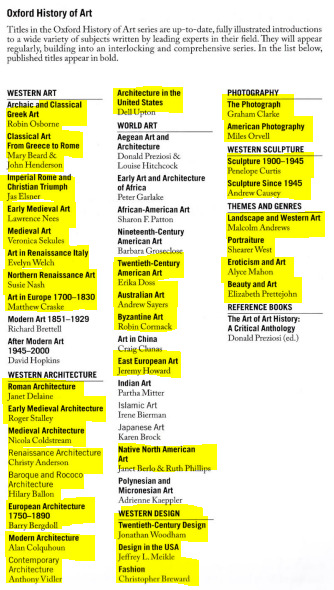
I recommend reading Craig Clunas books if you’re interested in Chinese Art and Art History in China as he is an incredible Art Historian and very well versed. Speaking of Chinese art, I present a Ming Dynasty scroll:
youtube
This YouTube video does an incredible job of displaying the whole scroll, rather than cutting it up like in photos.

Xia Chang (1388-1470), Bamboo-Covered Stream in Spring Rain, 1441, handscroll, ink on paper, 41.3 x 1500 cm, Art Institute of Chicago
This scroll was made around the same time as the Renaissance was beginning/happening in Florence, it’s a very contemplative view of nature and draws on calligraphy. While it does not display as much detail, that is to not say that it doesn’t evoke emotion and stir the viewer. Originally this was a private gift exchange, which at the time in China was a common occurrence.
Zhou Jihong of Haiwu built a house at Xichou, where ten thousand long bamboo trees surround the stream. I love the quiet and beautiful scenery of stream and rocks, and the green and moist color of bamboo is enough to clean away worldly worries. One day Jihong had his second son, Tingyue, bring me a roll of blank paper and ask for a painting of bamboo. At that time, I was enjoying the coolness at the Pine Pavilion; therefore, I thought about the scenery and painted the Bamboo-Bordered Stream in Spring Rain. Although my painting cannot match the old masters’ essence of learning, it resembles the scenery of Xichou. I wonder if Jihong, who is a scholar of profound knowledge, has the same feeling when he looks at this painting. On the first day of the sixth month, in the xinyou year of the Zhentong reign [1441], Xia Chang Zhongshao of Dongwu.
We are very used to seeing old maps of the world, from the Eurocentric perspective, but what about maps from other nation/country perspectives? Cartographer books help Art Historians to understand other perspectives/what other nations may consider important as it’s closest to them/in their vicinity. It also helps show and track the development of a nation in a way, as you see their world expand in their maps you understand the influences and countries, they have connections too.
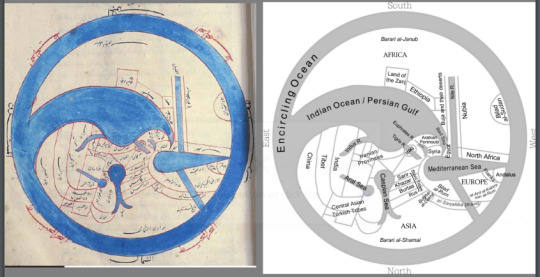
Map of the world from al-Istakhri, Kitab al-Masalik wa-al-Mamalik (Book of Roads and Kingdoms), 1470s, Istanbul, Sülemaniye Camii Kütüphanesi, Aya Sofya 2971a, f3a.
Another thing art reveals, apart from location and trade, it can also reveal religion and it’s spreading into other cultures. For example, this artwork has no real background or noted background, much of its history is lost and so we can only speculate. This artwork is believed to be from Kosovo, and given the rich history there, especially with the Ottomans, we can only guess at what it’s depicting: one such answer (and favoured) is a Christian institution in the Ottoman empire. We know it’s from around the 15th century and contains inscriptions. We also see Bells in the artwork, which is most associated with churches as opposed to other religious houses, and the interior of the building is covered with wall paintings perhaps of Mary or Jesus on the donkey. And the head coverings are non-Islamic.
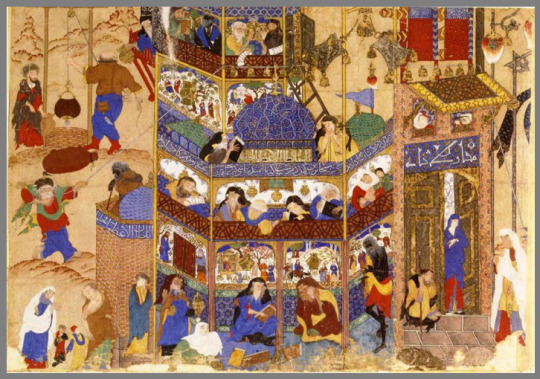
Monastery Scene, Iran, fifteenth century, opaque pigment, ink and gold on paper, 34 x 48cm, Topkapı Sarayı Müzesi, Istanbul, H.2153, f.131b
While we have little context, this artwork was found stuck into another book, like a scrapbook. This lack of context means we must refer to cultural background to make the history. We do know that Persian art draws on many artistic backgrounds.
This next painting comes from Spain, Barcelona. A large-scale painting, part of many other paintings in a giant altarpiece, or rather put behind the alter. While looking straight on from a photo doesn’t do this painting justice for its scale and gold detailing, and it’s low relief like sculpture aspect to it.

Reconstruction of the St Augustine Retable for the church of St Augustine, Barcelona, commissioned from Jaume Huguet 1463
This painting has colonial history to it, while our lecturer realised it predated the slave trade and Spain plundering of America (1492), it did not predate Spain and Portugal’s plundering of Africa. Economic history factors into current art and art ownership. Note: Europe imports many luxury items and good, apaying with vast amounts of gold as it doesn’t have luxury goods to send back. So where does the gold come from when it’s predating the America’s. Africa of course, pillaging the caravans filled with Gold that travelled across the Sahara and other places.
Now keeping this knowledge in mind, turn your attention to the painting, and a secondary photo from a visit in person, notice all the gold low reliefs.
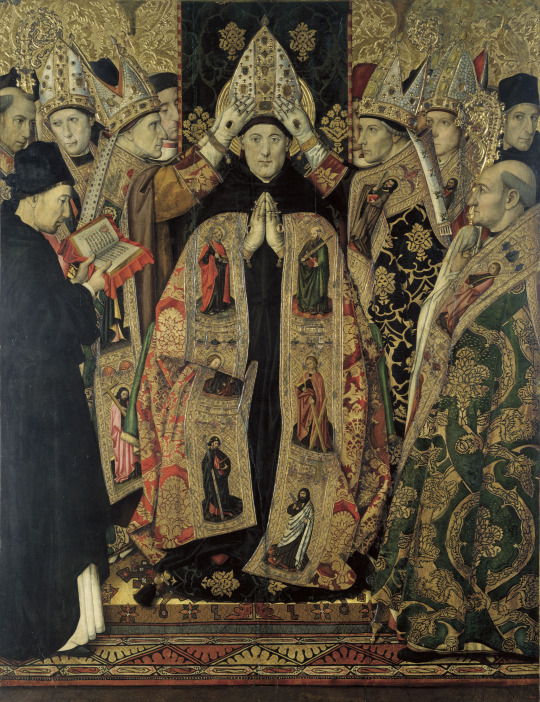

Jaume Huguet, The Consecration of Saint Augustine, between 1463 and 1486, tempera on panel, 250 x 193 cm, Museu Nacional d'Art de Catalunya, Barcelona

The Catalan Atlas, c. 1375, Bibliothèque Nationale, Paris
Once more cartography books boost Art History, showing world views of the historical world and in art. While this Atlas has a great many details, I would like to highlight a specific part, which relates to the aforementioned painting from Spain. When in the 15th century Portugal and then Spain navigated North Africa.

'This black Lord is called Musse Melly and is the sovereign of the land of the black people of Gineva (Ghana). This king is the richest and noblest of all these lands due to the abundance of gold that is extracted from his lands.’
Musse Melly is where the gold comes from, and this man was a real Lord. There are records of his travels across Africa to Egypt, and giving away do much gold in Egypt it ruined the economy for many years.

PART 2 OF POST: BENIN ‘BRONZES’
#Youtube#art show#art gallery#art hitory#artists on tumblr#architecture#art#artwork#history#histoire#writing#art tag#essay#paintings#art exhibition#essay writing#artists#writers#art history#writeblr#history lesson#historical#life lessons#lecture#learn#academic writing#on writing#writer#world building#world
17 notes
·
View notes
Text
The Man from The Isle of Malta: Baron Mikel Scicluna
The Man from The Isle of Malta: Baron Mikel Scicluna
Robert Segedy
“In the corner to my left, from the Island of Malta, weighing in 275 pounds, Baron Mee-gel See-Cluna.” Joe McHugh.
To readers of a certain age hearing that introduction on a Saturday morning would induce chills. The Baron started his career under the name of Mike Valentino in the 1950’s in Canada. It wasn’t until 1965 that he became the infamous “Baron Mikel Scicluna” when he…

View On WordPress
0 notes
Text
hello, cluna here!
i'm (tentatively) re-entering my tumblr era after 2 long years 🫣
on this blog you will find:
my fics (+ accompanying graphics)
my art (do not repost!)
you can also find me on twitter <3

1 note
·
View note